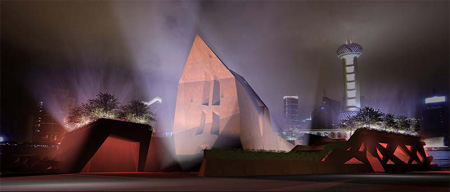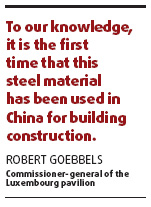|
 An artist's rendition of Luxembourg pavilion. [Courtesy photo]
An artist's rendition of Luxembourg pavilion. [Courtesy photo] |
The best things come in small packages.

Luxembourg has taken this old English proverb to heart in building its pavilion, a pocket-sized fortress that will open its chambers to Expo visitors in May.
Running under the theme of "Small is Beautiful", the pavilion is surrounded by medieval towers as part of its aim to highlight its Roman history. It will also showcase its natural landscapes and emphasize how its eco-political balance has enabled it to develop into the world's top producer in terms of per-capita gross domestic product.
Bereft of huge metropolises, Luxembourg nonetheless intends to show how a better life can be created even in small cities by adopting sustainable ways of development.
"The objective is to demonstrate the concept of sustainable development through the structure and the content of the pavilion," said the pavilion's Commissioner-General Robert Goebbels.
With grapevines wrapped around its base to symbolize forestry, the 3,000-sq-m structure will convey a strong China connection as the Mandarin translation of Luxembourg is "forests and fortresses". The pavilion cost 9 million euros ($12.6 million) to build.
It is the first and largest self-built structure that the country has put together for a World's Fair since the 1958 Brussels Expo and will feature a special outer layer made from a weathering steel.
Also known as corten steel, this was designed to have its rust-like exterior color with age, thus hinting at the country's romantic past.

"To our knowledge, it is the first time that this steel material has been used in China for building construction," said Goebbels, adding that it has only previously been used in ship construction.
Like the wood and glass used to build the rest of the pavilion, the exterior shell is recyclable and speaks of the country's reputation as the green heart of Europe, said designer Francois Valentiny.
Meanwhile, the latest technologies will be used to enhance visitors' experience.
A two-way audiovisual transmission satellite connecting Shanghai to Luxembourg will allow people from both countries to communicate in real-time.
The pavilion will also have a section introducing the village of Schengen.
The eponymous Schengen Agreement is a visa policy that allows tourists from visa-restricted countries like China to hop across several European borders for a more comprehensive tour of the Continent.

